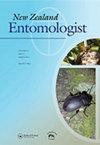巨型柳蚜(半翅目:蚜科:柳蚜科)从新西兰向西传播至澳大利亚的可能性
IF 0.4
4区 农林科学
Q4 ENTOMOLOGY
引用次数: 2
摘要
巨型柳蚜(Tuberolachnus salignus, Gmelin)分别于2013年12月和2014年3月在新西兰和澳大利亚首次报道。寄主植物是柳树和杨树的各种成员。蚜虫进入澳大拉西亚的途径尚不清楚,但通过塔斯曼海的自然空中传播可以解释它在澳大利亚和新西兰3个月内首次出现的原因。总结了以前蚜虫穿越塔斯曼海的例子。根据过去的经验,从澳大利亚到新西兰的主要西风更有可能通过风传播。然而,我们使用HYSPLIT空气轨迹模型证明,蚜虫可能是从新西兰到塔斯马尼亚南部的反向轨迹携带的。如果不对新西兰和澳大利亚的昆虫生物群进行更定期和系统的监测,将继续难以确定引进昆虫的时间、起源和传播途径。本文章由计算机程序翻译,如有差异,请以英文原文为准。
Possible windborne transmission of giant willow aphid Tuberolachnus salignus (Gmelin) (Hemiptera: Aphididae: Lachninae) westward from New Zealand to Australia
ABSTRACT The first records of Tuberolachnus salignus (Gmelin), the giant willow aphid, were reported from New Zealand and Australia in December 2013 and March 2014 respectively. The host plants are various members of Salix and Populus. The pathway used by the aphid to enter Australasia remains unknown, but natural aerial dispersal across the Tasman Sea is proposed to explain its first appearance within 3 months in Australia and New Zealand. Previous examples of aphids crossing the Tasman Sea are summarised. Windborne transmission due to the predominantly westerly winds from Australia to New Zealand is more likely based on past experience. However, we demonstrate using the HYSPLIT air trajectory model that it is possible that the aphid was carried on a reverse trajectory from New Zealand to southern Tasmania. Without more regular and systematic surveillance of New Zealand and Australian insect biota, it will continue to be difficult to ascertain the timing, origin and dispersal pathways of introduced insects.
求助全文
通过发布文献求助,成功后即可免费获取论文全文。
去求助
来源期刊

New Zealand Entomologist
ENTOMOLOGY-
CiteScore
0.70
自引率
33.30%
发文量
3
审稿时长
>12 weeks
期刊介绍:
The invertebrate diversity of New Zealand is of great interest worldwide because of its geographic isolation and geological history. The New Zealand Entomologist plays an important role in disseminating information on field-based, experimental, and theoretical research.
The New Zealand Entomologist publishes original research papers, review papers and short communications. We welcome submissions in all aspects of science regarding insects and arthropods in a New Zealand or Australasian setting. The journal’s subject matter encompasses taxonomy, phylogenetics, biogeography, biological control and pest management, conservation, ecology and natural history.
The journal is the official publication of the Entomological Society of New Zealand. Papers published or submitted elsewhere for publication will not be considered, but publication of an abstract or summary elsewhere (e.g. conference proceedings) does not preclude full publication in the New Zealand Entomologist. Accepted papers become copyright of the Entomological Society of New Zealand. The journal is published in English, but we also welcome publication of abstracts in Maori.
 求助内容:
求助内容: 应助结果提醒方式:
应助结果提醒方式:


